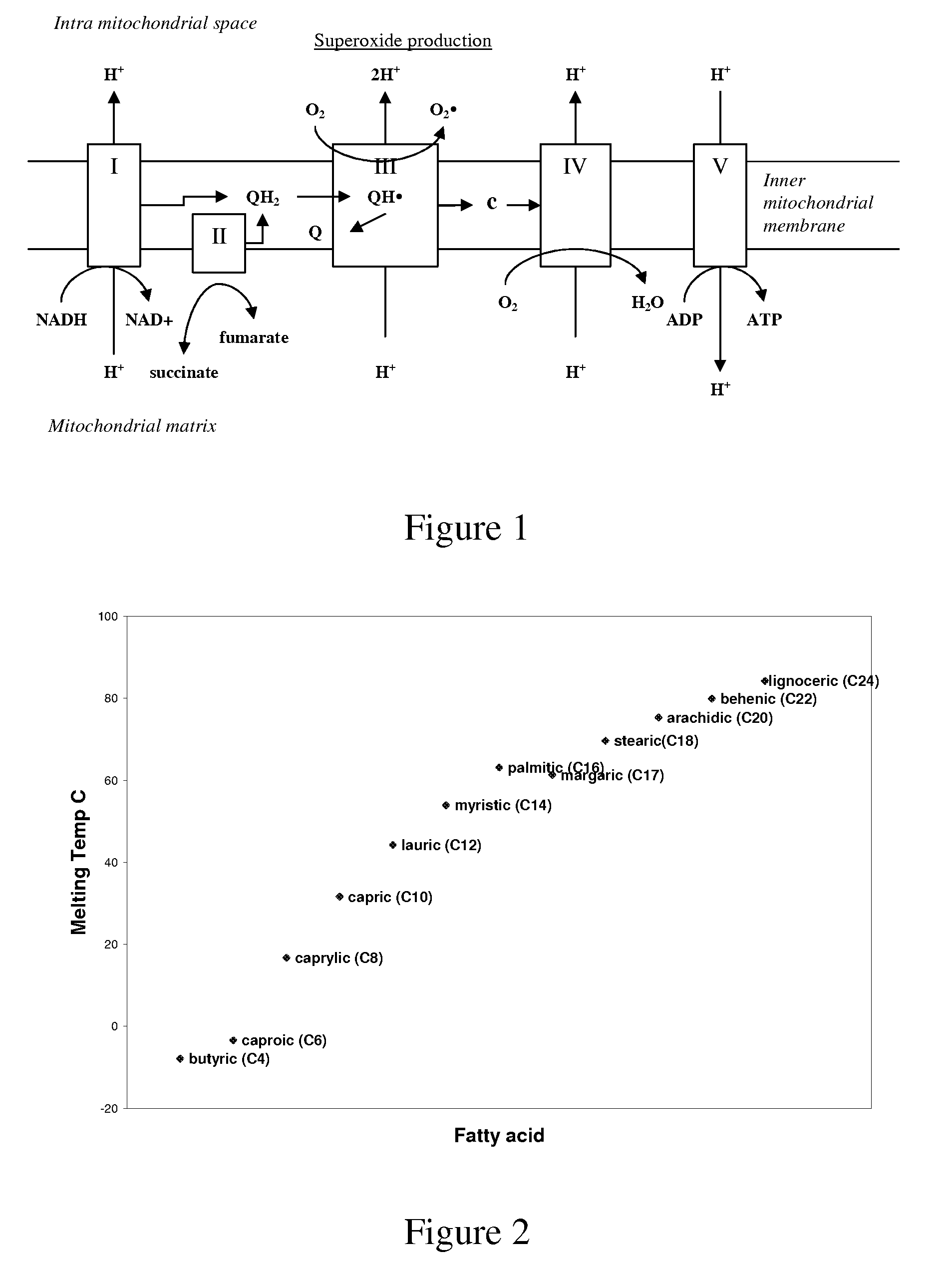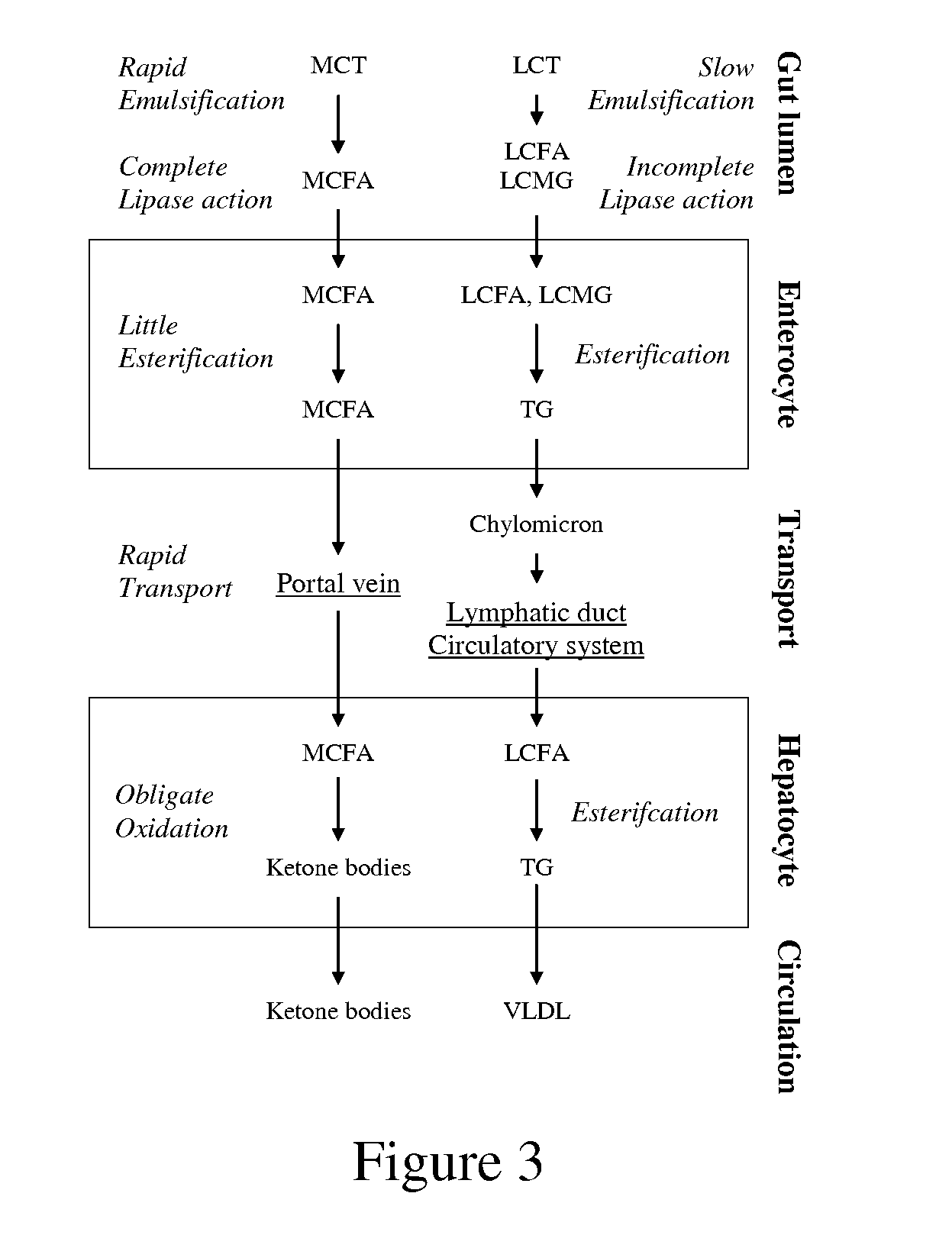Method to reduce oxidative damage and improve mitochondrial efficiency
a technology of mitochondrial efficiency and oxidative damage, applied in the field of mitochondrial function modulation in an animal, can solve the problems of affecting the normal function of the cell, and damaging all classes of cellular components,
- Summary
- Abstract
- Description
- Claims
- Application Information
AI Technical Summary
Problems solved by technology
Method used
Image
Examples
example 1
[0082] Reducing oxidative damage and improving mitochondrial efficiency. Two groups of aged beagle dogs were tested for the effects of feeding MCT on oxidative damage and mitochondrial efficiency. The first group was maintained on MCTs (2 g / kg / day) and the second group on placebo control over a 2-month period. Blood samples were taken over 5 time points to monitor levels of the ketone body, beta-hydroxybutyrate (BHB). After two months of treatment, the dogs were anaesthetized and brain biopsies were collected for mitochondrial analysis. The animals were then euthanized and brain tissue was harvested for further analysis of mitochondrial function and protein levels. The animals receiving MCTs had increased levels of serum BHB. They also had healthier mitochondria, as evidenced by better coupling of respiration with ATP formation. Finally, the mitochondria showed decreased signs of oxidative damage.
[0083] The eight subjects (8-11 years) were divided into two equal sized groups, match...
example 2
[0129] Protection from hypoxia-ischemia. Ischemic events are common in both stroke and heart disease. By reducing oxidative damage and improving mitochondrial efficiency MCTs will provide protection and treatment for ischemia and ischemia / reperfusion events. An established rat hypoxia-ischemia model will be used. 7-day-old rat pups will be divided into three groups: control, hypoxia-ischemia plus dextrose, and hypoxia-ischemia plus MCT treatment. In MCT treated pups, 0.5 g / kg of MCTs will be administered by oral gavage 2 to 4 hours before hypoxia. To induce ischemia the right common carotid artery of will be ligated, followed by 90 minute of hypoxia (8% 02 and 92% N2) at 37° C. After hypoxia, MCTs and dextrose will be administered daily for an additional 2 days in the test groups. To evaluate protective effects on MCTs, brain weight, morphology, TUNEL assay, and DNA laddering will be evaluated. In addition, mitochondria will be isolated from each group and examined for State II resp...
example 3
[0131] Treatment of Parkinson's disease (PD). PD is a sporadic condition of uncertain etiology. However, several lines of evidence suggest that a defect in oxidative phosphorylation contributes to its pathogenesis. For instance, 1-methyl-4-phenyl-1,2,3,6-tetrahydropyridine (MPTP) is a neurotoxin that blocks complex I (NADH-ubiquinone oxidoreductase) of the mitochondrial electron transport chain and when animals are exposed to MPTP it causes a condition similar to PD.
[0132] 8- to 10-week-old male C57BL mice will be divided into four groups: control, MPTP treated plus dextrose, and MPTP treated plus MCT. In dextrose treated pups, 0.5 g / kg of dextrose will be administered by oral gavage 2 to 4 hours before MPTP treatment. In MCT treated pups, 0.5 g / kg of MCTs will be administered by oral gavage 2 to 4 hours before MPTP treatment. Each mouse will then be randomly assigned to receive four intraperitoneal injections of either MPTP (18 mg / kg of free base in saline) or saline at 2-hour int...
PUM
| Property | Measurement | Unit |
|---|---|---|
| melting point | aaaaa | aaaaa |
| melting point | aaaaa | aaaaa |
| melting point | aaaaa | aaaaa |
Abstract
Description
Claims
Application Information
 Login to View More
Login to View More - R&D
- Intellectual Property
- Life Sciences
- Materials
- Tech Scout
- Unparalleled Data Quality
- Higher Quality Content
- 60% Fewer Hallucinations
Browse by: Latest US Patents, China's latest patents, Technical Efficacy Thesaurus, Application Domain, Technology Topic, Popular Technical Reports.
© 2025 PatSnap. All rights reserved.Legal|Privacy policy|Modern Slavery Act Transparency Statement|Sitemap|About US| Contact US: help@patsnap.com



